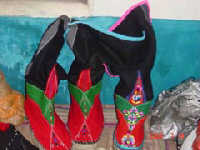|
Tibetan Boots
( 2005-10-27 )
 Tibetans, no matter men or women, generally wear boots. Tibetan boots have a great variety and a multitude of names.They are divided into three kinds, generally according to materials used: cowhide, corduroy and pulu. There are a range of sizes. Tibetans, no matter men or women, generally wear boots. Tibetan boots have a great variety and a multitude of names.They are divided into three kinds, generally according to materials used: cowhide, corduroy and pulu. There are a range of sizes.
Most boots are made straight without any difference between left and right feet, or between those for men or women's styles. They are divided into long leg boots and short leg boots, and unlined boots and cotton-padded boots.
The colors of Tibetan boots are exquisite. Some of the insteps are embroidered with silk thread into varying designs while others are edged with golden silk thread. The toecaps can be square, round, sharp or hooked. At the back of various boots, a 10cm-long mouth can be opened for the convenience of taking off or putting on the boot. Boots feature belts that are beautiful woolen handicrafts of various designs. Each end is decorated by colorful ears.
There are cross-shaped designs on the heads of cowhide and corduroy boots, and the soles are sewn with 5-7 layers of cowhide, the thickness of which is about 2 to 3 centimeters. On corduroy boots, a layer of canvas, and a layer of white cloth are lined within, and boots are edged with red cloth. The heads of corduroy boots are made of cowhide.
There are many kinds of pulu boots, with the soles made of cowhide, which sometimes differs in thickness by about 3 to 4 centimeters. The upper and leg part of the boots are made of different colors of pulu, and various patterns are embroidered on them.
Boots of Chamdo and northern Tibet are simple, honest, and tasteful, while boots of Shannan and Xigaze are delicate, careful, and refined. Boots in theLhasaregion incorporate the strong points of different places, including bright colors.
Tibetan boots are not only beautiful and tasteful, but also comfortable, durable and wear well. They are very popular among Tibetans and also favored by other ethnic groups nearby.
|

